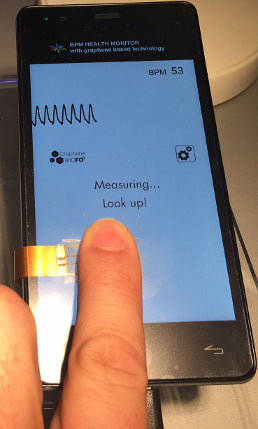Graphene shines at the Mobile World Congress
The Graphene Flagship had a pavilion at the Mobile World Congress (MWC) for the first time this year. The Graphene Pavilion was set up to show to the global technology leaders what graphene can do now and in the future.
The Flagship made sure to showcase graphene applications in all stages of development, from state of the art research results, to working prototypes, to finished products. Prototypes on display included a graphene piano, a low light sensor, a heart rate monitor, RFID tags, flexible Hall sensors and WiFi receivers, brain-machine interfaces...
Graphene-based sensors for biomedical applications and brain-machine interfaces were among the most interesting exhibits. Still in the research stage, these sensors have been attached to the brains of mice. Detecting small electrical signals from firing neurons at each sensor position allows local sensing of brain activity. Research is currently being conducted on slow wave sleep and epilepsy in animals, with the hope that epileptic seizures could be detected at their onset, and the patient and doctors alerted that a seizure is coming. Graphene poises an excellent platform for bio-sensors, due to its flexibility, electrical conductivity, and biocompatibility.
Image: Detail of a poster from ICN, CNM, and IDIBAPS about graphene bio-sensors.
Graphene and other 2D materials in general were indicated as an enabling technology for various types of flexible and transparent sensors, such as optical sensors, RFID, bio-sensors, gas sensors, etc. The high transparency of graphene was hailed as key in integrating sensors on transparent touch-screens. This application was demonstrated by a transparent graphene ECG attached to the screen of a smartphone. Visitors could measure their heart rates and add them to the database of MWC. Nearly invisible “health patches” like these could discreetly measure one’s health and communicate the results in real time to the patient or medical staff. The two dimensional nature of graphene enables optimal coupling to skin for reliable operation. Blood oxygenation is another parameter that should be possible to measure with a graphene patch.
A host of advanced graphene photodetectors was on display at the congress. Graphene has broadband light absorption, enabling detector operation throughout the UV, visible, infrared and THz parts of the spectrum, which is unmatched by other materials. The photodetectors can be flexible and highly transparent, if desired, or integrated on a wafer substrate for standard CMOS processing. Graphene photodetectors are fast, enabling ultrafast communication in data centers as well as in long distance links. Due to their high light sensitivity, graphene-based photodetectors can also be used for night vision, medical applications, security, food inspection, etc.
Image: Experimental graphene photodetector, made at ICFO.
Graphenea displayed our staple CVD graphene, the most widely used type of graphene for applications in electronics. We showed our graphene transferred on substrates commonly used in the industry (SiO2/Si, PET, Quartz...). In addition, most of the working prototypes were using Graphenea CVD graphene.
To say that the Graphene Pavilion aroused huge interest at the congress would be a gross understatement. On day one EU Commissioner Oettinger toured the pavilion, taking part in working prototype demonstrations. The Commissioner was excited by the achievements of graphene and possibilities of large-scale production demonstrated on site. Industry leaders were fascinated by the working prototypes, especially because this congress was the first opportunity to see so many at once.
Strong interest in the Pavilion on the first day of the congress generated wide press coverage, which in turn seemed to spur even more attendee interest the rest of the week. Business leaders of large multinationals showed a presence, expressing clear interest for collaboration with the Flagship. MWC was attended by leaders of AT&T, Cisco, China Mobile, Ford Motor Company, Facebook, Huawei, Intel, MasterCard, Mercedes Benz, Paypal, and other companies in this league. The Mobile World Congress is hosted by GSMA each year in Barcelona.
Overall MWC2016 was tremendous success for graphene, showing for the first time the fruits of Graphene Flagship labor over the past few years, all in one place and attractively presented to high-tech industry leaders.
Photo: Graphene fitness wearable.
Photo: Heart rate monitor.
Photo: Graphene Pavilion.
Photo: Camera sensor and health patch.
Photo: Graphene strain sensor on robotic arm.
Photo: Nobel prize winner Prof. Kostya Novoselov (left) with Prof. Frank Koppens (center left), John Hoffman, Director of the MWC (center), and Barcelona FC defender Gerard Piqué (right).








